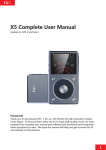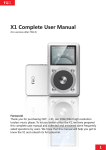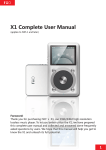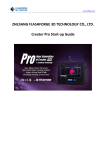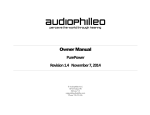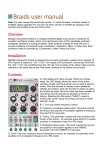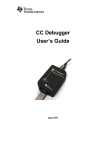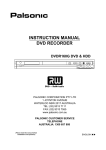Download FiiO X5
Transcript
X5 Complete User Manual Foreword: Thank you for purchasing FiiO’s X5, our 192k/24bit high resolution lossless music player. To let you better utilize the X5, we have prepared this complete user manual and collected and answered some frequently asked questions by users. We hope that this manual will help you get to know the X5 and unleash its full potential. 1 Contents A.Introduction B.Buttons and ports introduced 3 3-4 C.Firmware update 4 D.Pictorial guide to menu operation 5 E.Menu operation F.USB DAC function Preparation before installing USB DAC driver USB DAC driver installation procedure 6-9 9 9 - 9 11 Usage as USB DAC 11 G.Tips on usage 12 H.FAQ on the X5 13 1) About charging 13 2) Transferring songs 14 3) Firmware upgrades 14 4) Storage 15 5) Music playback 16 6) Other operations 17 7) Connection with other audio equipment 18 2 A. Introduction The X5 is a HiFi-class high resolution digital audio player, supporting lossy and lossless music formats including MP2, MP3, WAV, WMA, APE, FLAC, AAC, ALAC, OGG and AIFF. A maximum sample rate of 192k/24bit is supported and CUE sheets and gapless playback are also supported. Moreover, the X5 also functions as a USB DAC. The following sections are an illustrated guide to using the X5. B. Buttons and ports introduced (upgrade firmware via this slot) 16 Headphone out 13 15 Reset button ① Power / Lock key Line Out 14 Coaxial digital out 12 TF 1 Slot 11 12 TF2 Slot Data/charging USB port ⑨ Volume + ② Screen ⑨ Volume – ③ Shortcuts / main menu ⑥ Play/Pause/OK/Confirm (press and hold to show volume control dial) ⑦ Previous/previous song/rewind ④ Back / main menu (press briefly to go back up one menu level. press and hold to return to main menu. ⑤ Scroll wheel: item selection (rotates 360º) ⑧ Next/next song/ fast forward ⑩ Charging indicator 1)Power/Lock button: When the unit is powered off, hold the button for two seconds and release it and the X5 will power on (after a brief pause); when the unit is on, press the button briefly to lock / unlock the player, or hold the button for three seconds to power off (hold for ten seconds for a forced shutdown). 2)Display (262k color IPS display, 400x360 pixels): Displays the user interface and other information; for operating the unit in conjunction with buttons on the unit. 3 3)Shortcuts key / main menu: Press briefly to show / hide shortcuts context menu; hold to return to main menu. 4)Back / main menu: Press briefly to go back up one menu level; hold to return to main menu. 5)Scroll wheel: Freely rotatable, turn the wheel clockwise to scroll down / right, choose the next item on the menu or adjust the level / value / choice etc. for the selected menu item; turn the wheel counter-clockwise to scroll up / left, choose the previous item on the menu or adjust the level / value / choice etc. for the selected menu item in the other direction. 6)OK / Play / Pause: In “Now Playing” screen: press briefly to play / pause; In menus: press briefly to enter the submenu of the selected item, adjust the level / value / choice of the selected item (using the scroll wheel for items with numerical value or many choices, or alternating between choices using the OK button directly for other items); In other dialogs: press briefly to confirm actions (press other buttons to cancel); Volume control: Hold down this button at any time to pop up the volume control dialog and adjust the volume using the scroll wheel. 7)Previous song / up: In “Now Playing” screen: press briefly to select the previous song for playback, hold down to rewind the current song; In menus: press briefly to choose the previous item on menus. 8)Next song / down: In “Now Playing” screen: press briefly to select the next song for playback, hold down to fast-forward the current song; In menus: press briefly to choose the next item on menus. 9)Volume “+”/“-” buttons: press briefly to change volume by one increment, hold down to change volume continuously until the maximum volume (“+” button) is reached or the player is muted (“-” button) 10)Charging indicator: red while charging, green when fully charged. 11)USB data / charging port: for data exchange, battery charging, USB audio connection (when acting as USB DAC), USB OTG storage expansion. 12)TF / Micro SD card slots: Dual TF card slots, each supporting TF cards up to 128GB. 13)Line out port: 3.5mm analog audio line out port for connection to other amplifiers, such as the FiiO E12. 14)Coaxial output: 3.5mm coaxial digital audio output port, for connection to equipment with coaxial digital inputs. Headphone and line out ports will be muted when the coaxial port is connected. 4 15)RESET button: Push this button with a thin rod to reset and reboot the X5 in case of system error. 16)Headphone port: 3.5mm stereo headphone output port. Recommended headphone impedance: 16-300Ω. C. Firmware update Firmware updates may update the player with new features and optimize the playback experience; if you are satisfied with the current firmware, it is not necessary to upgrade it. The unit supports firmware upgrades via update files loaded into TF cards. Improper operation during firmware updates may cause the unit to malfunction! Please read the following instructions for firmware updates carefully before proceeding. To check the current firmware version: From the main menu, navigate to System Settings->About X5 to see the current firmware version loaded on your X5. Precautions before firmware update: •The TF card should preferably be a blank card of 32GB of capacity or under in FAT32 format. •Make sure the X5 is adequately charged (preferably fully charged) for the update process to prevent power failure during the update; •Do not operate other buttons and dials on the player during the update process. •If the update process fails, hold the power button for 10 seconds for a forced shutdown and turn the player on in update mode again to resume the update. Summary of TF card upgrade procedure: 1.Copy the x5.fw file provided by FiiO into the root directory of a TF card in FAT32 format; 2.Turn off the X5 and insert the TF card into slot 1 of the X5; 3.Hold the power button while holding the Shortcuts key (upper left key of the X keygroup) to turn on the X5 in firmware update mode. The following firmware update dialogs will appear and after the update is complete, the player will restart automatically. •After the update process is complete, please delete the x5.fw file from the TF card and update the media library. updating... update success Firmware update in progress Update successful 5 D.Pictorial guide to menu operation (no submenu) Adjust directly using Prev/Next/OK keys (with submenu) Press OK and adjust using scroll wheel Buttons and dial explained: Scroll wheel: scrolls through menu items, changes value of selected item OK / Confirm / Play / Pause: Enters next menu level, selects item for adjustment, stores changes Shortcuts key: shows / hides shortcuts context menu Back button: go back up one menu level Previous / up | Next / down: moves through menu items, changes value of selected item (stepwise) Prev/Next keys: change preset Scroll wheel to move between EQ bands, OK to choose EQ band, scroll wheel to adjust level of chosen EQ band, OK to store changes Select the source of music: TF slot 1, slot 2 or OTG storage Shortcuts key shows/ hides shortcuts context menu; navigate and select shortcuts menu items using scroll wheel and OK key Shortcuts key to start adding/removing songs from favorites, scroll wheel to choose song, Previous/Next keys to favorite/unfavorite song, OK to store changes All songs 1 2 3 4 56 7 Status bar: 1.Current volume 2.Current volume gain level 3.Name of current menu/display 4.Sleep timer is set 5.TF card(s) currently selected 6.Now playing 7.Battery level indicator Scroll to choose between selecting from all songs, albums, artists or genres; update media library first to show updated list of songs (no submenu) Adjust directly using Prev/Next/OK keys (with submenu) Press OK and adjust using scroll wheel 6 DAC Interface: USB DAC Playing interface USB DAC Settings interface Press the back key to switch X5’s USB DAC requires installation of dedicated drivers. Please refer to Section F: USB DAC for detailed instructions. If the USB mode is changed from DAC to Storage or vice versa while the USB cable is plugged in, the USB cable must be disconnected and reconnected for the X5 to be recognized in the new mode; When the X5 is connected to the computer in DAC mode, the DAC Playing interface is displayed by default. Pressing the back key switches between the DAC Playing and DAC Settings interface; holding down the back key sends the X5 back to the main menu and stops the USB DAC function. E. Menu operation Powering on and off Hold down the power button for two seconds and release it to turn on the X5 (language selection dialog would appear the first time the X5 is powered on); While the X5 is powered on, hold down the power button for 3 seconds to turn off the player. The X5 enters the main menu after it is powered on; use the scroll wheel or the Previous and Next buttons to choose between Now Playing, Favorites, Play by Category, Browse Files, System Settings and Play Settings; press the Shortcuts key to enter Play Settings directly. Now Playing While in the main menu, turn the scroll wheel to choose Now Playing and press OK. If no song is currently playing you will be shown a list of songs to choose from*. Use the scroll wheel and OK button to select a song and enter the Now Playing interface. *Note: songs list only appears after you have updated the media library. 7 a)Press the Shortcuts key briefly to pop up the shortcuts context menu; turn the scroll wheel or press the Previous or Next key to choose between shortcut menu items and press OK to apply the action, such as adding or removing the song from Favorites, changing play order or deleting the song. b)Turn the scroll wheel in the Now Playing screen to pop up a list of songs before and after the current playing song. Turn the scroll wheel to choose between songs, press OK to select and start playing the new song. Play by Category While in the main menu, turn the scroll wheel to choose Play by Category and press OK. You will be asked to choose between showing all songs, or showing a list of albums, artists or genres. Turn the scroll wheel or press the Previous and Next buttons to choose between the above and press OK to enter the chosen categorized listing. Favorites Add or remove favorites by - The Favorite button in the shortcuts context menu in the Now Playing screen (to add/ remove the current song from the list); or - Entering Favorites from the main menu. Press the Shortcuts key to batch add or remove songs (press OK to select and enter the songs list); use the scroll wheel to select a song, Previous or Next to add/remove a song from the list, and finally press OK to save changes. Play settings Turn the scroll wheel to choose between menu items and use the Previous, Next or OK key to choose between options on the chosen menu item. On items with a submenu (indicated by “>”), press OK to enter the submenu. a)Play mode Four play modes are available: sequential (plays to the end of the list and stops), loop all, loop single song and shuffle. b)Resume mode Controls where the X5 starts playing from when it is switched off and switched back on. Off: no memory of the last song played when X5 is switched off. Last song: resumes playback from the start of the last song played when the X5 was switched off. Last position: resumes playback from the last position on the timeline of the last song played when the X5 was switched off. 8 c)Gapless playback Turn this on to play e.g. a live performance divided into several tracks without breaks in between tracks. d)Max volume To protect your headphones and your hearing, the max volume can be limited to a value between 30 and 120 (unlimited maximum is 120). Press OK to show the adjustment submenu, turn the scroll wheel to adjust the limit value and press OK to store the change. e)Power on volume Last setting: recalls the volume set when the player was powered off. Fixed: always powers on the player at the volume defined in “Fixed volume setting”. Fixed volume setting: adjustable only when “Power on volume” is set to “Fixed”. Press OK to show the adjustment submenu, turn the scroll wheel to change the power-on volume setting and press OK again to store the change. f)Gain Gain Switchable between low and high, which correspond roughly to 0dB and 6dB gain respectively. g)Balance Press OK to adjust balance with scroll wheel (press OK to store change). The adjustment range is between +5dB to left channel and +5dB to right channel. System settings a)Language Press OK and use the scroll wheel or Previous / Next buttons to choose between English, Japanese, Korean, French, German, Spanish, traditional Chinese and Simplified Chinese. Press OK to store change or Back to cancel. The language setting is memorized even when the device is powered off or reset. b)Update media lib Update media lib Press the Previous and Next keys to choose between: Manual: updates the media library only when you press OK on “Update media lib”; Auto: updates the media library automatically each time after the X5 was connected to a computer as mass storage. Note: do not press any button or turn the scroll wheel during a library update. 9 c)Key-lock settings Press OK to enter the key-lock setting submenu and choose between lockscreen modes 1 or 2. As shown by the corresponding illustration onscreen; lockscreen mode 1 locks all keys except the power / lock button, while in mode 2, the volume keys, OK (Pause), Previous and Next buttons as well as the power / lock button are usable while the player is locked. d)Screen timeout The player turns off the screen and locks the keys automatically after the set delay when no buttons have been pressed and the scroll wheel hasn’t been turned. The set delay can be set between 30s, 40s, 50, 60s, 90s, 120 and never (always on) e)Backlight brightness Press OK to adjust the brightness (adjustable in 10 steps) using the scroll wheel and press OK again to store the change. f)Idle poweroff When this is set to on, the player will turn itself off after the set time when no music is playing and the user does not press any buttons on the player. Idle poweroff time When “Idle poweroff” is set to on, you may press OK to adjust the amount of idle time detected before the player shuts off. The set time is adjustable from 1 to 8 minutes. Turn the scroll wheel to adjust the set time and press OK to store the change. g)Sleep When this is set to on, the player will turn itself off after the set time while music is playing. Sleep timer When “Sleep” is set to on, you may press OK to adjust the amount of play time before the player shuts off. The set time is adjustable from 10 to 120 minutes. Turn the scroll wheel to adjust the set time and press OK to store the change. h)USB mode Two choices are available: Storage: when the X5 is connected to a computer via USB, allows access to TF cards inserted into the player like a card reader, for transferring songs. The cards will appear as computer drives. You can drag and drop, copy or delete songs and create directories to store songs. DAC: when the X5 is connected to a computer via USB, the X5 acts as a USB audio device and the DAC interface is shown. (driver installation and required; refer to Section F. USB DAC function for details) 10 i)About X5 Displays the name and model of the player, total and available capacities of TF cards inserted into the player and firmware version. Turn the scroll wheel clockwise to read our copyright declaration and then the quick start guide to the X5. j)Format Press OK to select a TF card slot for formatting into FAT32 format for use with the X5. k)Reset factory defaults Resets all settings to factory defaults. Also useful for recovering from any system malfunctions. Equalizer There are several preset equalizer settings as well as a custom setting available. Press the previous and next keys to switch between presets (Normal, Rock, Classical, Jazz, Pop, Dance, Vocal, Blues and Metal) or select the Custom setting. When the Custom setting is selected, turn the scroll wheel to choose between different frequency bands, press OK to select a frequency band for editing and turn the scroll wheel to adjust the frequency band up or down, then press OK to store the change and use the scroll wheel to choose another frequency band for editing. Press the back button at any time to exit from equalizer settings back into the main menu. Browse Files Select this to enter the songs browsing interface (browsing by folders and filenames). First the icons for TF slots 1 and 2 and the OTG external storage will appear. If a card is inserted into the slot or OTG external storage is connected, the corresponding icon will be selectable; otherwise the icon will be greyed out. Turn the scroll wheel to select a TF card slot or the OTG external storage and press OK to browse the music files contained therein. Songs will be displayed with the icon on the left while folders will be displayed with the icon on the left. Turn the scroll wheel to select between items, press OK on a song to play it or press OK on a folder to enter the folder. Press the back button to go back up one folder level or hold down the back button to return to the main menu. Note: OTG external storage connection has yet to be implemented owing to compatibility issues. This function will be added in a coming firmware update. 11 F. USB DAC function Preparation before installing USB DAC driver USB DAC driver installation on the computer is required before using the X5 as a USB DAC with it. Things to prepare before installing the USB DAC driver: •the computer •USB cable to connect the computer and the X5 (provided in the X5 package) •The USB DAC driver (to be downloaded from the FiiO website (https://www.dropbox.com/s/3kqjgvzu4nuvid2/Driver%20for%20X5%20USB_ DAC.zip) Precautions 1.For desktop computers, connect the X5 to a USB port on the rear of the case, not the front. This is because front USB ports on desktop computers are connected to the motherboard via long unshielded cables. As a result, front USB ports have low power output, low transfer speeds and are prone to electrical interference, degrading sound quality or causing crackling / dropouts. 2.When the X5 is decoding 192k/24bit audio via USB, the required data throughput is huge. A high quality USB cable, with low signal loss and good shielding, is required. Please use the original USB cable provided with the X5 if possible. If you need to purchase another cable, please do not buy generic USB cables (including cables provided with most smartphones), but buy USB-tomicro-USB cables from a reputable brand supporting the USB2.0 standard. 3.If the X5 doesn't work as a USB DAC after installation of the driver, please try rebooting the computer. 4.With Windows XP computers, the X5 will not enter the DAC interface before installation of the driver. This is normal. You may proceed with installing the driver normally. 5.Known issue: the driver will fail to install on Windows 8 64bit computers. This is related to the driver signature module. The driver has not been signed for Windows 8 64bit and will not work while driver signature enforcement is in effect. Please disable driver signature enforcement as follows: Mouse over upper right corner of screen->settings-> Change PC settings->General->Advanced->start-up->Restart now-> Troubleshoot->Advanced options->Start-up Settings->Restart After such a restart, the computer will be able to install unsigned drivers, but give a warning when this happens (as is the case with installation in XP, Vista, Windows 7), just click “Install anyway” to proceed. Please refer to this video for a walkthrough of the process: http://www.youtube.com/watch?v=NM1MN8QZhnk 12 USB DAC driver installation procedure (using Windows 7 as example) 1.Set the X5’s USB mode to DAC (main menu->System settings->USB mode) 2.Connect the X5 to a USB port on the computer using the provided USB cable (for desktop computers, a direct connection to a USB port on the back of the case is recommended); Double-click setup.exe in the provided USB DAC driver package and the following dialog appears: Click Next Click Install to install the driver to the default location 13 While the installation is proceeding, the following warning dialog will pop up more than once (usually twice). Select “install this driver software anyway” each time the dialog pops up: The following dialog will appear indicating a successful installation; click Next to continue. Click Finish to complete installation. The following icon should appear in the bottom right corner of the screen: 14 After the driver is installed, go to Control Panel->Hardware and Sound-> Sound and set “FiiO X5” as the default Playback audio device to play audio from the computer through the X5. FiiO X5 Usage as USB DAC When the X5’s USB mode is set to DAC, it enters the DAC Playing interface when connected to a computer via USB. Back key: press briefly to enter DAC Settings interface, press again to return to the DAC Playing interface. Hold to exit USB DAC mode and return to the main menu. OK button: hold down to show the volume control dial, turn the scroll wheel to change the volume. Please note that to have your computer play songs through the DAC, you have to make it the default playing device. This can be set in the sound control panel in Windows or the System Preferences/Sound on the Mac. G. Tips on usage This section contains some useful tips for you to get the most out of your X5. 1)Media library update It is recommended to set this to Auto, so that the X5 will update the media library after each time you connect it to the PC. If an update hangs on a song and will not continue (the number does not change), eject the TF card(s) to stop the update, clear the database by updating without cards inserted, insert the TF card(s) again and update again. 2)How to play your favourite songs quickly Go to the Favorites menu to add a batch of your favorite songs (or favorite individual songs as they are played in the Now Playing screen) and then enter the favorites menu to enjoy all your favorite songs. The X5 supports addition and removal of songs defined in .cue files as well for your enjoyment of lossless rips of CD/DVD/etc. 3)How to quickly cut over to the song you want to listen to Turn the scroll wheel in the Now Playing screen to pop up a list of songs before and after the current playing song. Turn the scroll wheel to choose between songs, press OK to select and start playing the new song. 15 4)Adjusting the volume easily While the screen is on, the volume control dialog will appear anytime the volume up/down buttons are pressed or the OK buttons is held for one second. When the volume control dialog appears you may adjust the volume stepwise using the volume buttons or use the scroll wheel to change volume quickly. If you would like to be able to change volume while the player is locked, set Key-lock Settings (in System Settings) to Lockscreen 2 to keep the volume buttons unlocked while the player is locked. 5)Turn on Resume mode to get back on the groove quickly Under Play Settings, Resume mode controls the playback behaviour of the X5 when you turn it back on. Setting this to Last Song allows the player to start playing again from the last song before the X5 was powered off while Last Position even remembers where you were up to in the track you were playing. 6)How to set the Gain and realize gapless playback function When using different headphones and earphones, the gain level may need to be changed. For most earphones and efficient, low impedance headphones, we recommend using low gain; for high impedance and / or low-sensitivity headphones, we recommend using high gain. Gapless playback means going from one music file to the next without a pause in between. Enable gapless playback on the X5 by entering Play settings from the main menu and setting the Gapless playback option to On. (Note: gapless playback is not supported in shuffle and loop-single-song modes.) 16 H. FAQ on the X5 1)About charging Q:What power sources may be used to charge the X5? A:The X5 may be charged by any USB charger with 5V output voltage and 1.5A or greater output current; in a pinch you can also charge it using a computer USB port, albeit slowly. Q:What is the charging current of the X5 while charging? A:About 470mA through a computer USB port or 1.3A through a dedicated USB charger (while unit is powered off). Q:How long does it take to charge up the X5? A:A full charge through a dedicated USB charger (DC 5V, 2A) takes about 4 hours. Q:Can the X5 be charged by a portable USB charger? A:Yes, as long as the charger is capable of 1.5A or greater current. Q:Can the X5 play songs while charging? A:Yes, but it is recommended to power off the X5 for charging, to prevent the charge from taking too long and prevent the X5 from heating up too much. Q:Can the X5 be connected to chargers via other micro USB cables? A:Yes, but the micro USB cable that comes with the X5 is specially constructed with thick power line conductors to minimize power loss while charging. Using other micro USB cables may lead to slower charging; very poor quality USB cables may cause so much power loss through the cable as to fail to charge the X5 altogether. Q:Why does the X5 charge so slowly or not at all through a front USB port on a desktop computer? A:The front USB ports on a desktop computer are connected to the motherboard through long thin cables, which cause too much voltage drop when connected to high current draw equipment like the X5. Q:How to judge the X5’s charging status? A:Below the scroll wheel, there is a charging indicator LED, which lights up red while charging and green when fully charged. The battery level of the onscreen battery gauge (on the upper right corner while the player is on, or taking up the whole screen if the player is off) moves to indicate battery charging. 17 2)Transferring songs Q:What operating systems does the X5 support (for transferring songs)? A:In Storage mode, the X5 operates as a USB Mass Storage class device and is supported by all OSes that support USB Mass Storage. This includes 32bit and 64bit Windows XP, Windows 7 and 8*, as well as Mac OS 9, X, and most versions of Linux and Unix. Q:What USB ports are the X5 compatible with? A:The X5 is compatible with USB 2.0 (and all later standards that are backwards compatible with 2.0, including 3.0* and 3.1*). *See last note in this section Q:How quickly does the X5 transfer songs? A:This is dependent on the size of files / songs transferred; average read / write speeds are about 4.5MB/s. Q:Is a driver required for connecting the X5? A:No driver is required for transferring songs (using Storage mode); a driver installation is required the first time the X5 is connected as a USB DAC. Q:Does the X5 support Linux or (insert OS name here)? A:Theoretically all OSes supporting USB Mass Storage are supported, but we cannot guarantee support through actual testing of all the various OSes out there. Q:Why is my X5 not recognized through a USB3 port or on Windows 8? A:USB3 ports and Windows 8 are new standards; although they are theoretically backwards compatible with previous standards, in practise devices may need to be optimized for forward compatibility with these new standards and as such the X5 may not be recognized through some USB3 ports or on some Windows 8 computers. We will remedy the situation as soon as possible through firmware upgrades. If you run into such problems in the meantime, the temporary solution in the meantime is to transfer through USB2.0 ports and Windows 7 / Windows XP. If these options are not available you may transfer through a supported card reader before transferring the card to the X5. 18 3)Firmware upgrades Q:How to know what firmware version is on my X5 and what is the newest version? A:The current firmware version can be viewed via System Settings->About X5. All firmware versions may be downloaded via http://www.fiio.net/support/ download.aspx. Q:How to update the X5 firmware? A:Please refer to Section C. Firmware Update in this user manual. Q:Is it possible to brick the X5 while upgrading the firmware? What to do if my X5 is bricked? A:It should not be possible to brick the X5 in the normal course of upgrading its firmware. If you somehow manage to brick it, please contact us via [email protected] and we can instruct you on how to unbrick it. 4)Storage Q:What cards does the X5 support? A:The X5 supports TF cards (also known as micro SD cards), including SDHC and SDXC. Q:Is the X5 picky about cards? A:The X5 has been tested to support major brands such as Sandisk and Kingston very well. It is beyond our ability to test every other brand out there, but any genuine card from a semi-reputable brand should work with the X5. To prevent slow card speeds causing the X5 to stall while playing or be unable to play high bitrate lossless tracks (such as 192k/24bit APE files), please use TF cards of Class 6 or above. Q:What size of cards does the X5 support? A:The X5 is currently tested to support cards up to 128GB. It is recommended to format the cards in FAT32 format. Q:How to format the TF card into FAT32 format? A:Simply insert the card into a slot in the X5, go to System Settings->Format, select the slot of the card to be formatted, press OK to select and OK again to confirm formatting the card to FAT32 format. Warning: all data and existing songs on the card will be deleted, please make backups on your computer first as necessary. 19 Q:Nothing from the TF card shows on the X5? A: 1.Play by Category will not show any songs from a card unless and until a media library update has been performed. Go to System Settings->Update Media Lib, press OK to perform a manual media library update. Or use Browse Files and select the corresponding TF card slot to confirm that the files on your card are recognized by the X5. 2.If neither of the above works to show you the songs on your card: i.Go to System Settings->About X5 and check that the Available Capacity of the TF card you inserted is shown correctly (comparing it to the info shown on your computer); if not, try formatting the card using the X5 and putting your files back on the card; ii.If this does not help, you may try formatting the card into NTFS format using Windows; iii.If none of the above helps, it is recommended that you try another card with the X5. Q:Some songs on the TF card don’t show on the X5? A: 1.Have you performed a media library update after you last loaded songs onto the card? Go to System Settings->Update Media Lib, press OK to perform a manual media library update. 2.If songs are still missing (or if they don’t appear even in Browse Files), try updating the X5 to the latest firmware. 3.After updating to the latest firmware, try updating the media library again. Q:Does the X5 support NTFS format? A:Yes, but only FAT32 format cards can be used for firmware upgrades. Q:How to delete X5’s media library database file? A:Eject all TF cards (and any OTG storage) from the X5 before updating the media library. The X5 will delete the media library database file automatically. 20 5)Music playback Q:Why would some mp3s not play? A:The X5 does not play some low bitrate or sample rate mp3s, specifically sample rates under 32kHz and bit depths under 16bit are not supported. Q:Why does my .wav files not play? A:Please check using Foobar2000 or other capable software on the computer to see whether the wave file is actually DTS or Dolby encoded multichannel audio, or perhaps a wave file of bit depth over 24 bits (32bit and 64bit files are not supported). Q:Why does my .ape files not play? A:APE comes in 5 levels of compression, including Fast, Normal, High, Extra High and Insane. Extra High and Insane encoded APEs are not supported while Normal and High encoded APEs are only supported at 94k/24bit or below. Q:Does the X5 support cue sheets? A:The X5 supports external cue sheets for identifying and playing a cue’d music file as separate tracks. Q:Why is my cue sheet not supported? A:Embedded cue sheets are not supported. Also please make sure that the . cue file is named the same as the music file that it cues. Q:Why do my lyrics not show? A:The X5 only supports external .lrc files, named after the music file it lyricizes. Q:Why am I seeing rubbish characters? A:Only ANSI encoding is supported for .cue sheets while ANSI and UTF-8 (with BOM) encodings are supported for lyrics. Q:Why do my new songs not appear under any Category? A:Please go to System Settings->Update Media Lib and press OK to update the media library for new songs to be indexed under Play by Category. You may also press Previous or Next to set Update Media Lib to Auto. Q:Why does no sound play from the X5 after disconnecting the X5 in USB DAC mode while it is decoding? A:Disconnecting the X5 while it is decoding is an “unclean” removal of a USB device, bound to leave some residual abnormalities. Please turn the X5 off and on again to continue enjoying your music. 21 6)Other operations Q:Why is the X5 sometimes sluggish in responding? A: 1.High bitrate lossless tracks, particularly 192k/24bit APEs, take more system resources to decode, possibly causing slowdowns in the player UI. You may convert such APEs to FLACs or uncompressed WAVs using programs such as foobar2000 on the computer first to make it easier on the player. The sound quality will be the same. 2.Placing too many songs on the X5 may also contribute to slowdowns. Please limit the number of songs on the X5’s TF cards where possible. 3.Placing non-music related files on X5’s TF cards, such as videos and pictures, may cause the X5 to slow down while sifting through them looking for music files. It is recommended to dedicate TF cards on the X5 to music. 4.Playing high bitrate files from slow TF cards may cause stuttering. Class 6 or above genuine microSD cards are recommended. 5.Unpredictable ordering of files, such as placing several .ape and .cue files in the same directory. The following directory structure is recommended: create separate folders for albums by the same artist, and open subfolders within each artist folder to hold single albums in separate subfolders. 6.A mixture of music files of several different codecs and sample rates may also slow down the player. It is recommended to place files of different codecs and sample rates into separate folders and to play files of the same type in sequence from these folders, to prevent the X5 from having to switch between different decoders frequently. Q:Why does the X5 get a bit hot in operation? A:The X5 utilizes an SoC with dual cores and high clock speed, a separate DAC, and (also separately) a high power headphone amplifier, thus dissipating way more power than consumer DAPs typically performing computation, DAC and amplification all on the SoC. Apart from outputting more power to your headphones, a lot of this power is also dissipated as heat, thus causing the X5 to heat up slightly in operation; this does not endanger the X5 or the listener in any way. 22 Q:Why does the X5 make a clicking sound when turning on / off and when headphones are inserted / removed? A:The X5’s headphone output goes through a relay to the headphone output. The relay disengages briefly when the X5 is turning on and off and when headphones are connected / disconnected from the X5, thus isolating headphones from potentially dangerous transient pops when the amplifier section is powered on and off. The relay is a mechanical connection that makes a small clicking sound when engaging / disengaging. 7)Connection with other audio equipment Q:How to connect the X5’s line out to other audio equipment? A:The X5’s line out outputs an unamplified signal to e.g. amplifiers, receivers, headphone amplifiers, car audio inputs, etc. The fact that it’s an “unamplified signal” can be misleading however. The line level signal of the X5 is of a higher voltage than the headphone out at all but the highest volumes and can damage headphones if you connect them directly to the line out. Please keep the line out port covered (e.g. using the provided silicone case or port covers) when not in use to prevent accidental insertion. Also, some audio equipment (e.g. car audio receivers) cannot handle a high line input voltage and will distort when connected to the X5’s line out. If you find this to be the case, you may try connecting it to the X5’s headphone out instead and adjust the X5’s volume to a suitable level for output to your audio equipment. Q:How to connect the X5’s “Coax out” to other audio equipment? A:X5’s “Coax out” outputs an S/PDIF compliant coaxial digital audio signal, and may be connected to decoders, DACs, receivers etc. with S/PDIF coaxial input ports using regular 75ohm coaxial RCA cables via the provided 3.5mm-RCA adapter. 23























